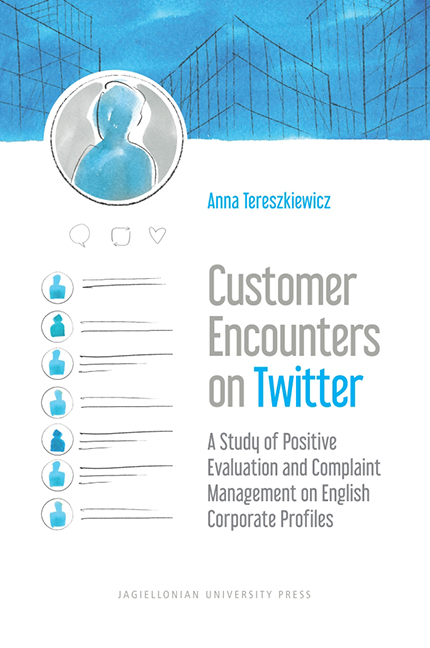 Customer Encounters on Twitter
Customer Encounters on Twitter Book contents
- Frontmatter
- Table of Contents
- Acknowledgements
- Introduction
- Chapter 1 Social media and corporate communication
- Chapter 2 Customer encounters as a genre of social interaction
- Chapter 3 Corporate profiles on Twitter – general characteristics
- Chapter 4 Positive evaluation and complaint management on Twitter
- Chapter 5 Selected politeness and lexicogrammatical properties of the tweets
- Conclusions
- References
Chapter 1 - Social media and corporate communication
Published online by Cambridge University Press: 09 February 2022
- Frontmatter
- Table of Contents
- Acknowledgements
- Introduction
- Chapter 1 Social media and corporate communication
- Chapter 2 Customer encounters as a genre of social interaction
- Chapter 3 Corporate profiles on Twitter – general characteristics
- Chapter 4 Positive evaluation and complaint management on Twitter
- Chapter 5 Selected politeness and lexicogrammatical properties of the tweets
- Conclusions
- References
Summary
Social media as a channel of communication
Social media have been defined as “online tools and platforms that allow Internet users to collaborate on content, share insights and experiences, and connect for business or pleasure” (Strauss and Frost 2009: 329) or “a group of Internet-based applications that build on the ideological technological foundations of web 2.0 and that allow the creation and exchange of user generated content” (Kaplan and Haenlein 2010: 61). In other studies, the term “social media” refers to “activities, practices, and behaviours among communities of people who gather online to share information, knowledge, and opinions using conversational media” (Safk o and Brake 2009: 6) or to “the sharing of information, experiences, and perspectives throughout community-oriented websites” (Weinberg 2009: 1). The aspects underlined in the above-mentioned definitions, determining the nature of social media, comprise engagement in connecting, sharing and creating user-generated content.
Social media encompass different channels of online communication, such as blogs, social networking sites (e.g. Facebook, Twitter, Instagram), professional networking (e.g. LinkedIn), video sharing (e.g. YouTube), picture sharing (e.g. flickr), review sites and social bookmarking (e.g. delicious, digg), social sharing of knowledge (e.g. Wikipedia), discussion forums and virtual worlds (Palmer and Koenig-Lewis 2009, Zarella 2010).
Basic functionalities of these services comprise allowing individuals to construct a profile (public or semi-public), compose a list of users with whom the individuals connect within the system, navigate through the list of connections (boyd and Ellison 2008: 211), interact with connected users, disseminate, like or comment on the content distributed within the network.
Twitter represents an example of a social networking service. Social networks are a category of social media defined as “virtual communities created for people to connect with others by means of popular web-based tools” (Wallace et al. 2011: 102). The tools comprise Web 2.0 applications allowing users to create and share user-generated content within their network of connections.
Research has shown that Internet users exploit different services simultaneously because each medium offers unique affordances (Phua et al. 2017a, 2017b). The choice of the medium is motivated by prior attitudes, self-regulation, media self-efficacy or habitual behaviour (Dimmick et al. 2004, LaRose and Eastin 2004, Ko et al. 2005).
- Type
- Chapter
- Information
- Customer Encounters on TwitterA Study of Positive Evaluation and Complaint Management on English Corporate Profiles, pp. 13 - 40Publisher: Jagiellonian University PressPrint publication year: 2022


